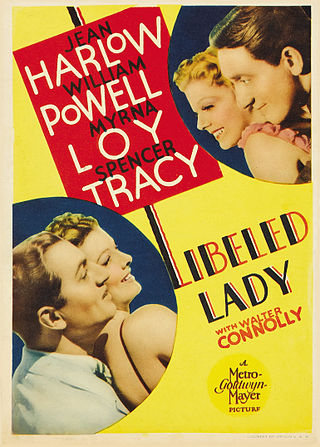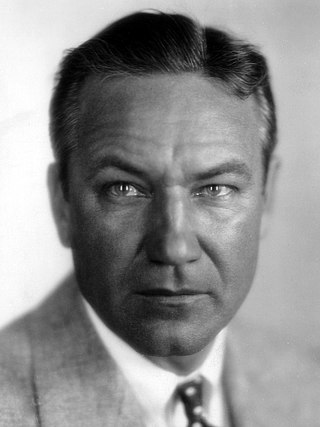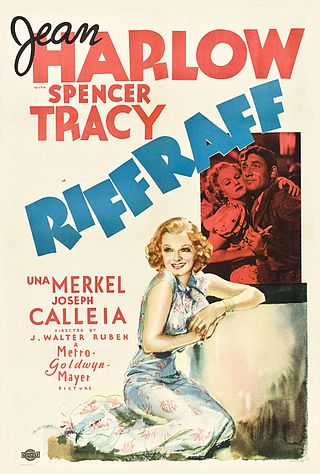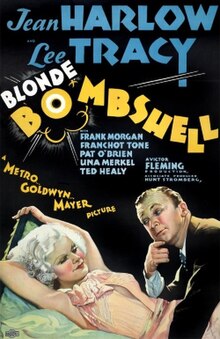
Libeled Lady is a 1936 American screwball comedy film directed by Jack Conway and starring Jean Harlow, William Powell, Myrna Loy and Spencer Tracy. It was written by George Oppenheimer, Howard Emmett Rogers, Wallace Sullivan, and Maurine Dallas Watkins. This was the fifth of fourteen films in which Powell and Loy were teamed, inspired by their success in the Thin Man series.

Stanislaus Pascal Franchot Tone was an American actor, producer, and director of stage, film and television. He was a leading man in the 1930s and early 1940s, and at the height of his career was known for his gentlemanly sophisticate roles, with supporting roles by the 1950s. His acting crossed many genres including pre-Code romantic leads to noir layered roles and World War I films. He appeared as a guest star in episodes of several golden age television series, including The Twilight Zone and The Alfred Hitchcock Hour while continuing to act and produce in the theater and movies throughout the 1960s.

Victor Lonzo Fleming was an American film director, cinematographer, and producer. His most popular films were Gone with the Wind, for which he won an Academy Award for Best Director, and The Wizard of Oz. Fleming has those same two films listed in the top 10 of the American Film Institute's 2007 AFI's 100 Years...100 Movies list.

Jean Harlow was an American actress. Known for her portrayal of "bad girl" characters, she was the leading sex symbol of the early 1930s and one of the defining figures of the pre-Code era of American cinema. Often nicknamed the "Blonde Bombshell" and the "Platinum Blonde", Harlow was popular for her "Laughing Vamp" screen persona. Harlow was in the film industry for only nine years, but she became one of Hollywood's biggest movie stars, whose image in the public eye has endured. In 1999, the American Film Institute ranked Harlow number 22 on its greatest female screen legends of classical Hollywood cinema list.
John Lee Mahin was an American screenwriter and producer of films who was active in Hollywood from the 1930s to the 1960s. He was known as the favorite writer of Clark Gable and Victor Fleming. In the words of one profile, he had "a flair for rousing adventure material, and at the same time he wrote some of the raciest and most sophisticated sexual comedies of that period."

Red-Headed Woman is a 1932 American pre-Code romantic comedy film, produced by Metro-Goldwyn-Mayer, based on the 1931 novel of the same name by Katharine Brush, and a screenplay by Anita Loos. It was directed by Jack Conway and stars Jean Harlow as a woman who uses sex to advance her social position. During the course of the film, Harlow's character breaks up a marriage, has multiple affairs, has premarital sex, and attempts to kill a man.

Red Dust is a 1932 American pre-Code romantic drama film directed by Victor Fleming, and starring Clark Gable, Jean Harlow, and Mary Astor. It is based on the 1928 play of the same name by Wilson Collison, and was adapted for the screen by John Mahin. Red Dust is the second of six movies Gable and Harlow made together. More than 20 years later, Gable starred in a remake, Mogambo (1953), with Ava Gardner starring in a variation on the role Harlow played and Grace Kelly playing a part similar to one portrayed by Astor in Red Dust.

Dancing Lady is a 1933 American pre-Code musical film starring Joan Crawford and Clark Gable, and featuring Franchot Tone, Fred Astaire, Robert Benchley, and Ted Healy and His Stooges. The picture was directed by Robert Z. Leonard, produced by John W. Considine Jr., and was based on the novel of the same name by James Warner Bellah, published the previous year. The movie had a hit song in "Everything I Have Is Yours" by Burton Lane and Harold Adamson.

Dinner at Eight is a 1933 American pre-Code comedy-drama film directed by George Cukor from a screenplay by Frances Marion and Herman J. Mankiewicz, based on George S. Kaufman and Edna Ferber's 1932 play of the same title. The film features an ensemble cast of Marie Dressler, John Barrymore, Wallace Beery, Jean Harlow, Lionel Barrymore, Lee Tracy, Edmund Lowe, and Billie Burke.

Wife vs. Secretary is a 1936 American romantic comedy drama film starring Clark Gable, Myrna Loy and Jean Harlow. Directed and co-produced by Clarence Brown, it was the fifth of six collaborations between Gable and Harlow and the fourth of seven between Gable and Loy. The screenplay was based on the short story of the same title by Faith Baldwin, published in Cosmopolitan magazine in May 1935. The screenplay was written by Norman Krasna, John Lee Mahin and Alice Duer Miller.

Hugh Ryan "Jack" Conway was an American film director and film producer, as well as an actor of many films in the first half of the 20th century.

Reckless is a 1935 American musical film directed by Victor Fleming and starring Jean Harlow, William Powell, Franchot Tone, and May Robson. David O. Selznick wrote the story, using the pseudonym Oliver Jeffries, basing it loosely on the scandal of the 1931 marriage between torch singer Libby Holman and tobacco heir Zachary Smith Reynolds, and his death by a gunshot wound to the head.

Small Town Girl is a 1936 American romantic comedy film directed by William A. Wellman and starring Janet Gaynor, Robert Taylor, and James Stewart. The supporting cast features Binnie Barnes, Andy Devine, Lewis Stone and Edgar Kennedy.

Riffraff is a 1936 American drama film directed by J. Walter Ruben and starring Jean Harlow, Spencer Tracy and Una Merkel. The screenplay was written by Frances Marion, Anita Loos and H. W. Hannaford.

Harold G. "Hal" Rosson, A.S.C. was an American cinematographer who worked during the early and classical Hollywood cinema, in a career spanning some 52 years, starting from the silent era in 1915. He is best known for his work on the fantasy film The Wizard of Oz (1939) and the musical Singin' in the Rain (1952), as well as his marriage to Jean Harlow.

Saratoga is a 1937 American romantic comedy film starring Clark Gable and Jean Harlow and directed by Jack Conway. The screenplay was written by Anita Loos. Lionel Barrymore, Frank Morgan, Walter Pidgeon, and Una Merkel appear as featured players; Hattie McDaniel and Margaret Hamilton appear in support. It was the sixth and final film collaboration of Gable and Harlow.

The Girl from Missouri is a 1934 American romantic comedy-drama film starring Jean Harlow and Franchot Tone. The movie was written by Anita Loos and directed by Jack Conway.

Our Betters is a 1933 American pre-Code satirical comedy film directed by George Cukor and starring Constance Bennett, Anita Louise and Gilbert Roland. The screenplay by Jane Murfin and Harry Wagstaff Gribble is based on the 1917 play of the same title by Somerset Maugham. Tommy Atkins worked as assistant director, while the sets were designed by the art director Van Nest Polglase.

Man-Proof is a 1938 American romantic comedy film directed by Richard Thorpe. The film is based on the 1937 novel The Four Marys written by Fannie Heaslip Lea.

Jean Harlow was an American actress who made her uncredited debut in two 1928 films: Honor Bound for Fox Film; and Moran of the Marines for Paramount Pictures. While waiting for a friend at the studio in 1928, she was discovered by studio executives who gave her letters of introduction to casting agencies, where she was offered the two small roles that subsequently launched her film career. During the initial two years of her career, Harlow appeared uncredited in 16 films, including several Hal Roach productions developed for Laurel and Hardy. Her first speaking role was a bit part in the 1929 American pre-Code romantic comedy The Saturday Night Kid, starring Clara Bow and Jean Arthur. The film has since been preserved by the UCLA Film and Television Archive.


















